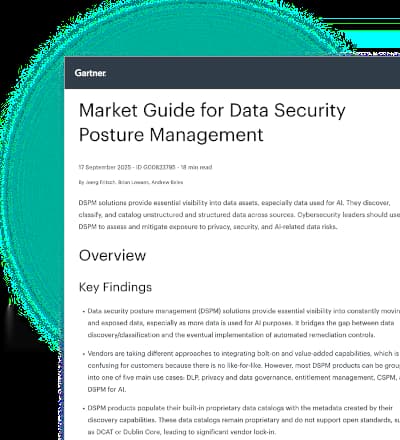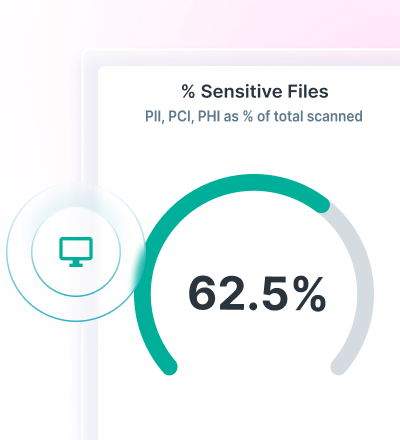
¿Lucha para ver datos en la nube?
No está solo. Con más de 800,000 aplicaciones en la nube en el mercado, las herramientas de seguridad de datos heredadas se ven abrumadas por las complejidades de la gestión de políticas de SaaS y la proliferación de datos impulsada por IA.
de las organizaciones han experimentado un
incidente de seguridad en la nube grave*
de los datos corporativos se
almacenan en la nube*
de las empresas carecen de visibilidad de los
datos accesibles a los agentes de IA***
Vea y proteja los datos en aplicaciones de SaaS y GenAI con CASB
Forcepoint CASB protege el acceso a las aplicaciones de SaaS más populares del mundo, como Microsoft 365, Google Workspace y Salesforce. La solución escanea datos confidenciales en reposo dentro de aplicaciones sancionadas por la empresa y ofrece visibilidad y control reales sobre los datos a través de una integración con el software de Forcepoint Data Loss Prevention (DLP).

Solución de CASB de Forcepoint vs. la competencia
Forcepoint | Proveedores de seguridad existentes | Proveedores de redes existentes | |
Características del Cloud Access Security Broker (CASB)
| |||
Funciones de seguridad de los datos
|
EXENCIÓN DE RESPONSABILIDAD: La comparación de productos se basa en las capacidades propias del producto y las integraciones entre carteras de productos disponibles del mismo proveedor al 1 de marzo de 2023. Las comparaciones no incluyen las integraciones con proveedores externos. La comparación de funciones se basa en la versión más reciente y moderna de cada proveedor al 1 de marzo de 2023. La información se basa en los datos recopilados de sitios web y foros públicos, artículos de analistas y hojas de datos de productos al 1 de marzo de 2023.
Capacidades críticas de CASB para mantener su SaaS seguro
Visibilidad profunda en los datos de SaaS
Obtenga visibilidad completa de los datos en aplicaciones de SaaS. Los dashboards predefinidos y personalizables empoderan a los equipos de seguridad, cumplimiento y auditoría para que actúen rápidamente con información intuitiva.
Proteja los datos y simplifique el cumplimiento
Extienda el mejor de su categoría de DLP a CASB para evitar la pérdida de datos en la nube. Optimice la configuración de políticas y la gestión del cumplimiento con más de 1700 clasificadores y plantillas de políticas.
Acceso seguro desde cualquier dispositivo
Capacite a los trabajadores híbridos con acceso seguro de Zero Trust a aplicaciones de SaaS desde cualquier dispositivo y ubicación. Los modos de despliegue sin agente mantienen a los usuarios productivos y a los datos protegidos.

Automatice la remediación de amenazas
Detecte y responda automáticamente a amenazas de SaaS como malware, sobreexposición de datos y violaciones de políticas en aplicaciones de SaaS para minimizar el impacto de las fugas.


Guía de estrategias de Microsoft 365 Data Security
Microsoft 365 se encuentra entre las aplicaciones en la nube más populares del mundo. Forcepoint CASB mejora la seguridad de los datos dentro de las aplicaciones de M365, aumentando la productividad de los usuarios y proporcionando a las organizaciones la confianza de que sus datos confidenciales están seguros.
Por qué los clientes eligen la solución de CASB de Forcepoint
Por qué los clientes eligen la solución de CASB de Forcepoint
"Very good experience in getting visibility into and protection of cloud application, policy enforcement and user behavior."
Lea la reseñaManténgase informado para proteger la nube
Preguntas frecuentes
¿Cómo se integra Forcepoint CASB con tantas aplicaciones en la nube?
Forcepoint CASB se integra con más de 800,000 aplicaciones en la nube mediante una combinación de métodos de proxy inverso y proxy de redirección. Este enfoque híbrido nos permite monitorear y proteger datos en prácticamente cualquier SaaS, IaaS o entorno de nube privada, independientemente de cómo los usuarios acceden a esas aplicaciones.
- Basado en API: Ideal para una visibilidad profunda en aplicaciones sancionadas, como Microsoft 365, Salesforce o Google Workspace. Nos permite auditar la actividad de los usuarios, detectar amenazas y aplicar políticas de DLP, incluso de manera retroactiva.
- Proxy inverso: Ideal para la protección en línea de tráfico en la nube desde dispositivos administrados. Permite el control de sesiones en tiempo real, como bloquear descargas o aplicar autenticación por pasos.
- Forward Proxy: Útil cuando se protegen dispositivos no administrados o escenarios de BYOD. Enruta el tráfico saliente a servicios en la nube a través del proxy de Forcepoint, lo que permite la implementación de políticas antes de que los datos lleguen a la aplicación.
¿Qué es una solución de Cloud Access Security Broker (CASB)?
Un Cloud Access Security Broker (CASB) es una solución de seguridad que actúa como intermediario entre los usuarios de la nube y los proveedores de la nube. Protege a las organizaciones de los ciberataques al prevenir el malware y proteger los datos a través de encriptación, lo que hace que los flujos de datos sean ilegibles para partes no autorizadas. Los CASB proporcionan seguridad de datos y gestión de acceso para aplicaciones de SaaS, garantizando un uso de la nube seguro y que cumple con las normas.
¿Cómo funciona y funciona un CASB?
El software de CASB protege los datos que fluyen entre arquitecturas de TI internas y entornos de proveedores de nube mediante la aplicación de las políticas de seguridad de una organización. Gobierna las interacciones de los usuarios con las aplicaciones en la nube y los datos dentro de ellas, garantizando un acceso seguro y conforme a los recursos en la nube.
¿Cuál es el propósito de un CASB?
El objetivo principal de un CASB es proteger los datos en aplicaciones en la nube administradas y no administradas. Permite a las organizaciones crear políticas que rijan el uso de los datos, mitigando riesgos como la exfiltración de datos y la fuga. Los CASB también abordan el desafío de Shadow IT al identificar y administrar aplicaciones de SaaS no autorizadas.
¿Cómo mejora un CASB la seguridad en la nube?
Un CASB mejora la seguridad en la nube al proporcionar visibilidad del uso de las aplicaciones en la nube, aplicar políticas de seguridad de datos y proteger contra amenazas. Monitorea la actividad de los usuarios, detecta anomalías y garantiza el cumplimiento de los estándares regulatorios. Al actuar como un punto de control de seguridad entre los usuarios y los servicios en la nube, un CASB ayuda a evitar las fugas de datos y el acceso no autorizado.
¿Cómo ayudan los CASB con el cumplimiento de normativas?
Los CASB ayudan con el cumplimiento de normativas al monitorear el uso de la nube y aplicar políticas que se alinean con las regulaciones de la industria, como GDPR, HIPAA, SOX y PCI DSS. Proporcionan informes y auditorías detalladas para demostrar el cumplimiento, lo que ayuda a las organizaciones a evitar multas y cuestiones legales. Los CASB también garantizan que los datos se almacenan y procesan de acuerdo con las leyes de protección de datos regionales.
¿Cómo enfrentan los CASB el desafío de Shadow IT?
Los CASB abordan el desafío de Shadow IT al descubrir y monitorear las aplicaciones en la nube no autorizadas que se utilizan dentro de una organización. Proporcionan visibilidad de todos los servicios en la nube, evalúan sus niveles de riesgo y aplican políticas de seguridad para administrar y controlar su uso. Esto ayuda a las organizaciones a mitigar los riesgos asociados con aplicaciones en la nube no aprobadas.
¿Por qué CASB es importante para las organizaciones que utilizan aplicaciones de SaaS?
Los CASB son cruciales para las organizaciones que utilizan aplicaciones de SaaS porque proporcionan una gestión de cumplimiento y seguridad integral. Ayudan a las organizaciones a obtener el control sobre los datos en la nube, a protegerse contra amenazas cibernéticas y a garantizar que el uso de la nube cumpla con los requisitos regulatorios. Los CASB también abordan los desafíos de Shadow IT al identificar y administrar aplicaciones en la nube no autorizadas.
¿Cuáles son los pilares de un CASB eficaz?
Visibilidad: Las empresas necesitan visibilidad sobre el uso de las aplicaciones en la nube, incluyendo cuentas de usuario, departamentos, ubicaciones y dispositivos, para garantizar que los activos de información estén controlados y cumplan con los procesos de gobernanza.
Seguridad de datos: Los CASB mejoran la Data Loss Prevention (DLP) al monitorear el almacenamiento de archivos en la nube y evitar el intercambio de datos no autorizado, que los productos de DLP tradicionales pueden omitir.
Protección contra amenazas: Los CASB detectan comportamientos internos sospechosos y mitigan los riesgos de ex empleados que aún pueden acceder a aplicaciones en la nube que contienen información confidencial.
Cumplimiento: Los CASB ayudan a las organizaciones a cumplir con las regulaciones regionales como SOX, HIPAA, PCI DSS, NIST, CJIS, MAS e ISO 27001, garantizando la privacidad de los datos y la seguridad.
BYOD, Shadow IT y aumento en el uso de la nube: Los CASB aplican políticas de acceso granulares para dispositivos administrados y no administrados, y abordan los desafíos que plantean las políticas de BYOD, las aplicaciones de SaaS y Shadow IT.
¿Cuáles son las características clave de una solución de CASB?
Las claves de una solución de CASB incluyen:
Visibilidad: Monitoreo e informes sobre el uso de las aplicaciones en la nube.
Data Security: Cifrar datos y aplicar políticas de Data Loss Prevention (DLP)
Protección contra amenazas: Detecta y mitiga amenazas basadas en la nube.
Cumplimiento: Garantizar el cumplimiento de las regulaciones y estándares de la industria.
Control de acceso: Gestiona el acceso de los usuarios a las aplicaciones y los datos en la nube.
¿Cuáles son los beneficios de una solución de CASB?
Los CASB mejoran la seguridad de datos para empresas que utilizan aplicaciones de SaaS populares, como Microsoft 365, Workspace y Salesforce.
Los beneficios clave incluyen, entre otros:
Visibilidad y control mejorados sobre los datos en aplicaciones de SaaS.
Protección contra amenazas basadas en la nube.
Proteja el acceso a numerosas aplicaciones de SaaS.
Mejora el cumplimiento de las regulaciones de privacidad de los datos globales y específicas de la industria.
¿Cómo calcula los ahorros de costos de un CASB?
Desplegar una solución de CASB puede reducir los costos operativos a través de:
Gestión eficiente: La aplicación de políticas de seguridad para todos los servicios en la nube desde una única plataforma reduce la necesidad de contar con equipos de seguridad extensos.
Mayor agilidad: La adopción de la nube segura mejora la productividad, acelera la entrega de aplicaciones empresariales, agiliza las actividades de fusiones y adquisiciones y reduce la deuda técnica.
Mayor automatización: El descubrimiento, la categorización, la aplicación de políticas y la remediación automatizados minimizan los recursos necesarios para la gestión de la seguridad en la nube.
Eliminación de aplicaciones en la nube redundantes: Identificar y eliminar aplicaciones en la nube innecesarias reduce los costos generales de servicio en la nube.
Eficiencia de utilización mejorada: Los inventarios de servicios en la nube exhaustivos ayudan a los equipos de TI a optimizar el gasto y a reducir la subutilización.
¿Cómo se diferencia CASB de DLP?
Un CASB combina varias tecnologías para proteger aplicaciones y datos en la nube, y actúa como firewall, filtro y proxy entre los usuarios y los servicios en la nube. Realizan funciones como descubrir aplicaciones en la nube, evaluar riesgos y aplicar políticas de seguridad. Los CASB utilizan gateways, datos de registro, agentes de endpoint y API para monitorear y analizar la actividad en la nube.
Las soluciones de DLP monitorean los datos dentro de entornos de TI, detectan fugas potenciales y bloquean actividades sospechosas con firewalls, tecnología de monitoreo, protección de endpoint y soluciones antivirus.
¿Cuáles son los beneficios de integrar CASB con DLP?
Integrar CASB con DLP ofrece varias ventajas:
Mejor cobertura: Cobertura integral de DLP en la nube.
Protección más fuerte: Seguridad de datos mejorada durante la migración a la nube.
Políticas unificadas: Aprovecha las políticas de DLP existentes para la infraestructura en la nube y on-premises.
Conocimiento más profundo: Mayor visibilidad del comportamiento del usuario y el uso de los datos en la nube.
* Snyk
** Exploding Topics
*** SailPoint













